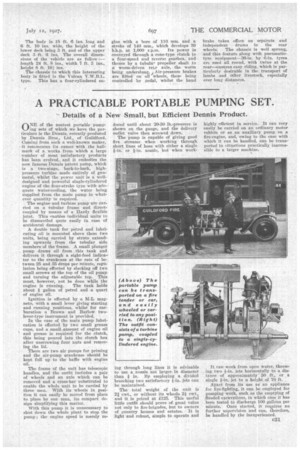• A PRACTICABLE PORTABLE PUMPING SET.
Page 53

If you've noticed an error in this article please click here to report it so we can fix it.
Details of a New Small, but Efficient Dennis Product.
ONEof the neatest portable pumping sets of which we have the particulars is the Dennis, recently produced by Dennis Bros., Ltd., of Guildford. Coming from snch a well-known maker, it commences ire career with the hallmark of a works from which a large number of most satisfactory products has been evolved, and it embodies the ROW famous Dennis patent pump, which is a two-stage, back-to-back, highpressure turbine made entirely of gunmetal, whilst the power unit is a welldesigned and powerful single-cylindered engine of the four-stroke type with ode--' quate water-cooling, the water being supplied from the main pump in whatever quantity is required.
The engine and turbine pump are carried on a tubular frame and directcoupled by means of a Hardy flexible joint. This enables individual units to be dismantled quite easily in case of accidental damage.
A double tank for petrol and lubricating oil is mounted above these two units, being carried by struts extending upwards from the tubular side members of the frame. A small plunger pump draws oil from this tank and delivers it through a sight-feed indica-, tor to the crankcase at the rate of between 25 and 35 drops per minute, regulation being effected by slacking off two small screws at the top of the oil pump and turning the adjustable top. This must, however, not be done while the
engine is running. The tank holds about gallon of petrol and a quart of engine oil.
Ignition is effected by a M-L magneto, with a small lever giving starting and running positions, whilst for carburation a Brown and Barlow twolever-type instrument is provided.
In the case of the main pump lubrication is effected by two small grease cups, and a small amount of engine oil and grease is required for the clutch, this being poured into the clutch box after unscrewing four nuts and removing the lid.
There are two air pumps for priming and the air-pump erankcase should be kept full up to the baffle with engine oil.
The frame of the unit has telescopic handles, and the outfit includes a pair of wheels and an axle which can be removed and a cross-bar substituted to enable the whole unit to be carried by three men. With its wheels in position it can easily be moved from place to place by one man, its compact design simplifying this matter.
With this pump it is unnecessary to shut down the whole plant to stop the pump ; the engine speed is merely re
duced until about 20-30 lb.-pressure is shown on the gauge, and the delivery outlet valve then screwed down: The pump is capable of giving good fire streams when working through short lines of hose with either a single fin. or Fin. nozzle, but when work ing through long lines it is advisable to use a nozzle not larger in diameter than I in. By employing a divided breeching two satisfactory fin. jets can be maintained.
The total weight of the unit is 21 cwt., or without its wheels21 cwt., and it is priced at £125. This useful little outfit should prove of great value not only to fire-brigades, but to owners of country houses and estates. It is light and robust, simple to operate and
highly efficient in service. It can very easily be carried on an ordinary motor vehicle or as an auxiliary pump on a fire-engine, and, owing to the ease with which it can be handled, can be transported to situations practically inaccessible. to a larger machine.
It can work from open water, throwing two fin. jets horizontally to a distance of approximately 50 ft., or ,a single Fin, jet to a height of 70 ft.
Apart from its use as an appliance for fire-fighting, it can be employed for pumping work, such as the emptying of flooded excavations, in which case it has been tested to discharge 100 gent:ins per minute. Once started, it revires no further supervision and can, therefore, be handled by the inexperienced.












































































































